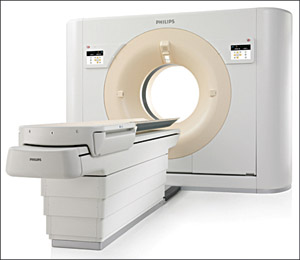Challenges faced. With a healthy innovation comes obstacles that need to be tackled. Talking about the challenges the Philips team faced whilst coming up with iDose4, Raveendran Gandhi says, “While transitioning from the existing, widely accepted FBP technology to IR technology through our basic first-generation iDose platform, and its innovative journey to graduate into the current fourth generation of iDose4, optimising and improving the product in every stage, we have surpassed several challenges.” Radiologists appreciate images, which have a natural appearance, devoid of all artefacts. “As each CT patient study may contain acquisitions of several hundred cross-sectional images of the body, those images were expected to be reconstructed under a minute to match with the busy patient workflow of a radiology department. Such ultrafast reconstruction requires very high computational power. Philips achieved reconstruction speed of 20 images per second through its Rapidview IR hardware. The other biggest challenge was to improvise the existing methods to significantly improve spatial resolution in order to drastically improve image quality. Despite these challenges, iDose4 acquired up to 68 per cent improvement in resolution,” added Raveendran Gandhi.
Hardware involved
“iDose4 is a sophisticated and complex reconstruction algorithm that demands enormous computational power,” says Raveendran Gandhi. The interaction of information between the projection and image domains requires the support of elegant software and hardware architectures. Running iDose4 on the prior generation of reconstruction hardware (RapidView) would result in clinically unacceptable reconstruction times.

The RapidviewIR reconstruction engine was designed from the ground to benefit from not only higher performance computational cores but also the number of cores. The architecture is highly parallel, and the design enables the reconstructor to scale with the latest multiple-core processors and state-of-the art massively parallel, high-density computing.
Raveendran Gandhi informs that the high-density computing device on Rapid View IR processes and transfers huge amount of data. The latest generation PCI express bus offers substantially higher I/O bandwidth and Intel 6-core processors are utilised to address the additional computing requirements. As a result, the new Philips RapidView IR reconstructor is able to deliver exceptional reconstruction performance with iDose4, thus providing reconstruction speeds similar to those previously achievable with FBP conventional reconstructors.
The iDose4 advantage
iDose4 enables significant dose reduction whilst preserving equivalent diagnostic image quality to a corresponding full-dose scan. Optimising the implementation of iDose4 on the Philips CT scanner platforms has enabled the additional clinical benefit of being able to adapt the spatial resolution and dose-reduction benefits to the specific clinical indication. “For example, for pediatric imaging, where radiation dose reduction is paramount, iDose4 enables significantly lower radiation dose whilst maintaining diagnostic quality. In other clinical scenario, such as coronary stent patency imaging, where image quality (spatial resolution) is of higher priority, iDose4 can be used to improve image quality by significantly improving spatial resolution. Intermediate levels of dose reduction and spatial resolution improvement can be applied in combination for other clinical scenario as well,” informs Raveendran Gandhi.
Something similar to iDose4?
“Most of the CT vendors are working towards technology which results in reducing radiation dose to patients. The performance efficiency of the desired product should be determined by its ability to adapt and integrate into the routine clinical work flow of CT department, its speed of image reconstructions, image quality and ease for technical use,” says Raveendran Gandhi. Traditionally, Philips always worked to adhere to as low as reasonably achievable principle in CT Imaging and consistently brought out solutions in practical low-dose technology and implemented in its CT product ranges.
In the future
“Our primary objective is to address the radiation dose issues mentioned earlier and provide the real benefit of low-dose, high-quality images to patients and radiologists. Our focus is to create and spread awareness about low-dose technology available with Philips for each and every CT investigation, routinely incorporated for every patient study,” says Raveendran Gandhi. He further adds, “We would like to enhance our brand and differentiate ourselves as a medical device manufacturing company, which is fully adapted to patient-first approach and care, and has truly proven its stand with this innovative technology.”
iDose4 is a fourth-generation product of iterative reconstruction technology. When asked if there would be plans in the future to incorporate additional features, Raveendran Gandhi says, “We do not anticipate further changes with iDose4 product technology. However, Philips is also progressing with unique horizons of low-dose technology, which is totally based on model-based reconstructions,” says Raveendran Gandhi. On asking him if iDose4 can be utilised with other CT scanners in the market, he says, “No, it will work only on Philips CT.”
The author is a senior technical correspondent at EFY Bengaluru






